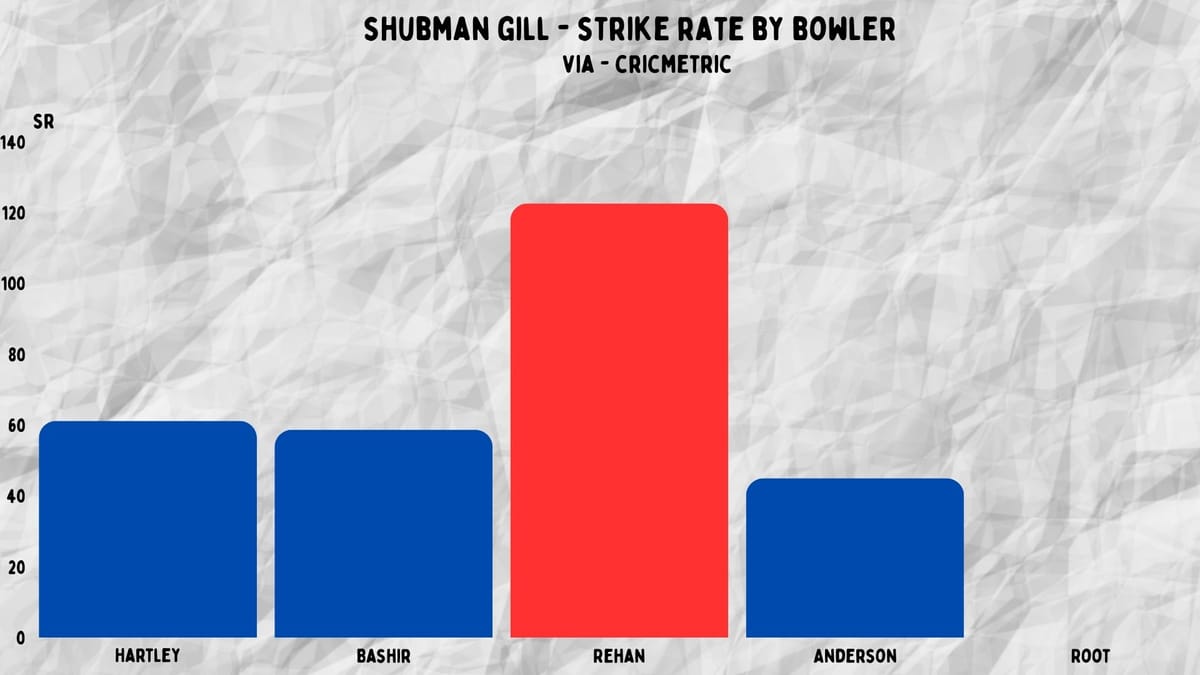Anderson and Gill star on Day 3 as the game poises for an exciting finish
Notes on Shubman Gill, James Anderson, and Axar Patel.

The jokes about clouds and Jimmy Anderson seem a little silly when he took Rohit with a ball so good it seemed unfair, and finally got Jaiswal as well. But England allowed for many singles, in part because their spinners can’t nail their length, and also because England protected the boundaries.
It was then time for Shubman Gill to make runs. Weird how batters look better on wickets that aren’t volcanic. But India still found ways to give wickets away when they had the game, and England keep themselves in another game. I mean from our perspective, from theirs they were willing to chase anything under 600.
They started the exact same way you would expect, trying to Scott Boland Mukesh Kumar out of the game. Also India forgot they had Ashwin and Axar, once they didn’t it looked different. But then Rehan Ahmed came in for his new role as nighthawk. Don't you think we all earned this?
Even when Bazball doesn't work, it feels like it's working.
Shubman Gill, and how it matters when you start (SAK)
Kevin Pietersen played all his Test cricket between the ages 25 and 33 - coinciding with his peak batting years. He didn't have to come in as a youngster, or play through the bad years later in his career.
It is worth remembering not everyone starts the same way. When you start playing really matters.
Pietersen also gave an example of Jacques Kallis' averaging only 22 in his first 10 Tests in his tweet, suggesting that Shubman Gill needed to be backed because of his talent.
I also thought of Steve Waugh while thinking of great batters who had slow starts. But you have to remember that Kallis and Waugh also gave their teams flexibility by being valuable on the other side of the ball too. Also, this does not mean that every young batting talent will come good just because they started badly.

If you're judging a young batter, two things are worth looking at - their first-class record, and if they have an obvious flaw in their game. With Gill, the bat away from the pad in a wobbleball era is interesting, because of the angle that people bowl to him. But I don't think it's enough to say that he would not make runs.
You can see Younis Khan and Mohammad Yousuf on this list, and they turned out to be two of the greatest Pakistani batters of all time. Younis is one of the best players of spin, and Yousuf probably makes the cut for the top 50-60 Test batters of all time.

Carl Hooper was clearly an above average Test batter towards the end of his career. But his overall average still just hovers around 36. Plus, the fact that he could bowl a bit of off spin also helped.
But a lot of the other guys did not go on to have good careers, despite the fact that they were talented enough to start before the age of 25. With Martin Guptill, it was clear that his batting skills were not exactly suited to red-ball cricket.
Gill averages about 7 runs less than the rest of the top six batters in his team, and about the same when compared to the opposition top six batters. But remember, most of them are facing better batters than him. He's still been underpar, but it's fair to say that the other Indian batters haven't had it that easy either.

He attacks the inexperienced leggie Rehan Ahmed, knocks it around against Hartley and Bashir, and plays out Jimmy Anderson (although he had a bit of a nervy start). This is what proper batting looks like - picking the right bowlers to score off.

He played a couple of cut shots, pulled a shorter one, and hit a straight six off the wrist spinner. This was a slightly low-pressure 3rd innings considering the first-innings lead, but they were two down early on and Anderson was bowling really well.

Axar Patel's improvement as a batter (SAK)
When he first came to international cricket, he was more of a bowler who could chip in with the bat once in a while. However, he has really transformed himself across formats in recent times. He is not quite a number 6 yet, but he can certainly slot in as a solid number 7 option in Test cricket.

Note that he has played all his Test cricket in Asia, in his peak batting years. He has a strike rate of 141.23 in T20s and 99.67 in ODIs, so his white ball numbers have also improved quite a bit.

So you could see that he plays spin really well. And while some of these pitches have been very spin-friendly, batting with the softer ball. Even then, his numbers are really solid for a lower-order batter than has bailed India out of trouble a few times.

It is fair to say that his low average against pace in ODI cricket is partly down to smaller sample size, plus getting out trying hit them at the death. I think what this graphic really tells us is that Axar prefers facing spin a lot more than pace in every format of the game.

When you get to your peak batting years, you start to think that it makes a lot more sense. A couple of technical changes and him understanding his game a little bit better certainly helped him here.

Axar Patel is a limited batter, but he keeps things really simple. That allows him to pick his shots and stick to it without trying anything too extravagant. He is a pretty good player of the cover drive against spin, and he can also knock the ball around on the leg side.

Jimmy Anderson - then and now (JK)
Jimmy Anderson is old, and when that happens we all think that every single thing happening to him must be because of his age. Like a few years back when he couldn’t take wickets in the fourth innings, the question was whether he was getting tired.
Then Jimmy Anderson had a putrid Ashes, he took five wickets in four Tests. And after one match on an Indian pitch he also has five. Obviously, this average won’t stay like this. But again it shows why we shouldn’t obsess over his age, and a few games where he struggles. Generally, with a bowler, it is really obvious when they are done. We are not there for Jimmy yet.
And here is why, this ball. We have seen Rohit Sharma out this way before. Those who haven’t played a lot of cricket think this he is playing the wrong line. But that is why this graphic matters. Rohit is being bowled because he is playing the right light.
This ball drifted (rather than fully swung) one degree towards the leg stump, the ball before was played from this place. But this one then seamed the other way. This is what bowlers hope happens. It almost never does, and to quote Anderson, “I wasn’t exactly trying to do what that ball did.”

Even Anderson can't regularly replicate a ball like this. But he did go pretty close, because even the one to Jaiswal seamed and swung. The wobbleball in the air and off the pitch.

Indian batters moving their feet (JK)
I thought India were quite apprehensive in this innings because they were in front, and we know that England makes things uncomfortable. Shubman Gill's foot is not set here. You can tell when batters are either slow, or tentative by their feet.
Sometimes your foot can be up in the air, but it's actually just because of how you are standing. But Jaiswal is still just landing in the position he wants to be in, and push their foot down onto the ground.
India's wickets to spin (JK)
So today, CricViz told me that India have lost 67% of their wickets to spinners in this series while playing an attacking shot. I think this was around 6/7 wickets down. According to them that is the highest such % for any team in a Test series in India (min: 20 wickets v spin).

There is a discussion to be made on how they got here. Is this England’s ability to manufacture wickets clashing with a weaker younger Indian batting line up?
They are not putting massive pressure on India, but perhaps they are trying to get India to play attacking shots and score quickly. Again, India seemed to have left some runs in the middle.
And they are in a situation where England think they can win it.



